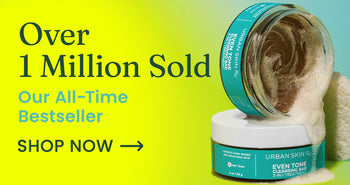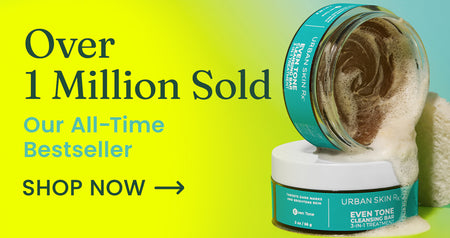How To Do Chemical Exfoliation At Home

If your skin is anything but even and bright all the time, you’ve probably looked into different treatments to improve your skin’s appearance.
This is probably especially true if you struggle with common but frustrating skin complaints like hyperpigmentation, uneven skin tone, blemishes, or even just noticing the first fine lines starting to develop around your eyes or forehead.
Many of us are always on the lookout for the miracle product that will resurface our skin texture and leave us feeling like we’re glowing from the inside out.
If your skincare routine isn’t quite cutting it at the moment, and your skin is struggling with seasonal changes or chronic issues, your usual skin-pampering of grabbing a drug store face mask before your next outing might not be strong enough to get the job done. But more extreme treatments like chemical peels or laser treatments can be expensive, and perhaps worse, time-consuming.
This is where chemical exfoliation really shines. It’s a great way to give your skin the pick-me-up it needs to soar through the winter doldrums and to take the edge off if you’ve had one too many late nights catching up with friends or family. Chemical exfoliation is also key if you’re trying to banish issues with pigmentation or acne, so whatever complaint you have about your skin at the moment, chemical exfoliation may help!
What Is a Chemical Exfoliant?
The word “exfoliation” is probably familiar to you. It’s an important part of your overall skincare that most people would recommend you work into your routine to help your skin stay healthy and bright. Many exfoliants are physical exfoliants, which is to say, slightly abrasive materials like a loofah or a facial wash with coffee grounds or even the classic sugar scrub.
By working something rough over the skin of your face (or body!), you can slough off any dry skin that may be lingering and help clear out any gunk that may be hiding in your pores.
It helps refresh your skin, and it generally feels really satisfying, even if it takes a while to see the full results. Exfoliation can be really important when it comes to fighting off signs of aging, blemishes or anything else that might disrupt the texture or tone of your complexion.
Chemical exfoliation is similar to physical exfoliation. The difference between the two is in the name: rather than using something abrasive, like granules, to brighten your skin, chemical exfoliants use chemicals.
How Do Chemical Exfoliants Work?
If you’re not familiar with chemical exfoliation just yet, hearing that you’re going to rub off some of your skin with chemicals can seem a bit scary. But don’t worry! This isn’t some kind of Joker origin story; chemical exfoliant skincare products are actually really good for your skin.
Chemical exfoliants are types of acids that help break the bond between the layers of your skin. By doing this, chemical exfoliants enable your skin to shed its older outer layer, leaving you looking and feeling refreshed. While your skin cells will naturally shed and regenerate over time, they go through different phases — using a chemical exfoliant ensures that you have your best, freshest, brightest skin much more frequently.
When you shed the outer layer of skin, you can also help improve the appearance of common skin issues like hyperpigmentation and blemishes. Chemical exfoliation can unclog your pores and get rid of any dead skin cell buildup that may be contributing to breakouts or redness, especially for acne-prone skin or oily skin.
Chemical exfoliation can also help control oil production, not to mention help reduce the appearance of any scars or dark blemishes you may have by forcing the skin to refresh itself.
What Kind of Chemical Exfoliants Can You Use?
There are a few different ingredients to look for when you’re trying to work chemical exfoliation into your skincare lineup. It’s important to understand the ingredients that go into your skincare products so you can be sure you’re selecting things that actually work! Chemical exfoliants fall into three main categories.
Alpha Hydroxy Acids
Alpha Hydroxy Acids, or AHAs, are a pretty well-known and well-loved skincare ingredient… and for good reason. AHAs help to dissolve the bonds your skin cells have between one another. This allows dead cells and old skin cells to be easily removed from your face. By doing so, you effectively resurface your skin, and are generally left with a brighter, more even complexion as a result!
Alpha Hydroxy Acids are generally safe for use. When you’re using a product meant for chemical exfoliation rather than chemical peels, the AHAs are generally formulated in low concentrations to be gentler on your skin while still brightening it.
However, AHAs can be drying and potentially a bit irritating to your skin, especially if you tend to have sensitive skin, so when you start using AHAs, it’s best to keep it to once or twice a week until your skin fully adjusts to the formula.
AHAs also make your skin more susceptible to sun damage, so it’s extra important to wear sunscreen if there are AHAs in your skincare routine. Examples of AHAs include Glycolic Acid, Lactic Acid, Citric Acid and Malic Acid. AHAs can be natural or synthetic.
Beta Hydroxy Acids
Beta Hydroxy Acids, or BHAs, mostly mean Salicylic Acid. If you struggle with blemishes, you’re most likely already familiar with Salicylic Acid because it’s a key ingredient in most breakout-busting products.
BHAs have soothing properties that make them great for reducing the appearance of redness. In addition to having some great effects on reducing the appearance of blemishes, like AHAs, Salicylic Acid has an exfoliating effect on your skin. BHAs are also clutch when it comes to getting rid of any oil or dirt that might be clinging to your skin, so it really is an all-around superhero if you’re interested in chemical exfoliation to improve your skin’s appearance and your main complaint is breakouts.
Like with AHAs, you’ll want to build up to using your BHA products over time to avoid any undue irritation that might make your skin worse.
Poly Hydroxy Acids
Poly Hydroxy Acids, or PHAs, are the gentlest of the three varieties of chemical exfoliants. PHAs include Gluconolactone, Lactobionic Acid and Galactose. Like the other varieties, PHAs exfoliate dead skin cells from the surface of your face and allow your true complexion to shine through.
The main difference with PHAs is — skip this bit if science makes you sweat — the size of the molecules. PHAs have bigger molecules, which stops them from getting as deep as AHAs and BHAs. While that might sound like a bad thing, it’s great if your skin is sensitive or if you’ve had a bad reaction to BHAs and AHAs in the past.
Are Chemical Exfoliants the Same as a Chemical Peel?
If you’re familiar with chemical peels and this is all sounding very familiar, you’re onto something!
Chemical peels often use ingredients like AHAs, BHAs or PHAs instead of super high concentrations of hydroxy acids. Rather than getting a gentle exfoliating effect, you’re not likely to feel beyond a slight tingle; you get a more comprehensive peel of your top layer of skin.
Chemical peels should be used more sparingly than your average chemical exfoliant because they’re so much stronger, and you need to be really kind to your skin after using them — and totally religious when it comes to applying sunscreen as chemical peels can leave your skin raw and vulnerable.
However, the results you get with chemical peels are undeniable. And if it all sounds ideal except for having to make a trip to the salon or dermatologist’s office, we have good news. You can get chemical peel kits that are safe to use at home, like our Medspa Edition: Complexion Correction Peel Pads. If you want glowing skin fast or just want to give yourself a bit of DIY pampering, chemical peel pads are a great option.
How Do You Use Chemical Exfoliation At Home?
Once you’ve decided which type of chemical exfoliant is best for your skin type and needs, all that’s left to do is use it. Luckily, chemical exfoliants aren’t particularly difficult to get down with!
As we’ve mentioned, though, it is important that when you start using an ingredient like BHAs, AHAs or PHAs, you work it into your routine gradually. Start by using your chosen product once or twice a week, and as long as your skin stays calm, you can increase your usage until you’re using it daily if you’d like. Always make sure to follow up with a soothing moisturizer, like one containing Hyaluronic Acid.
There are several different types of products you can get familiar with if you want to start taking advantage of the great benefits chemical exfoliation provides.
Exfoliating Pads
One of the easiest ways to work chemical exfoliation into your routine in literally one step is by using treatment pads that come preloaded with the good stuff.
If you’re not one for a long morning or evening routine, and you don’t want to waste another cotton round or dirty another sponge, this is your one-stop shop for improving the look of your skin.
Our Retinol Resurfacing Treatment Pads don’t just include Retinol. They’re also formulated with Lactic Acid, an Alpha Hydroxy Acid, which will give your skin the refresh it so desperately needs. After washing your face, you can chemically exfoliate in the morning or the evening.
If your skin is particularly sensitive, you can swipe the product over your face and let it rest for a good while before giving your face a quick rinse to remove any excess product that might irritate your skin.
Exfoliating Mask
If you’d rather get your chemical exfoliation only occasionally and in slightly higher doses, a face mask packed with chemical exfoliants may be perfect for you. Our Purifying 2-in-1 Pumpkin Pore Detox Mask and Scrub can give you a blast of Salicylic Acid that will leave your face fresh as can be, in addition to fighting breakouts.
If your concern is more about hyperpigmentation or acne scars, you might want to use a mask that includes AHAs, which will be better for targeting these issues than Salicylic Acid. If you are looking for a radiance-boosting mask that exfoliates and improves the appearance of fine lines, blemishes and dark marks for a more glowing complexion, try our Even Tone Smooth & Glow Enzyme Mask.
Exfoliating Cleanser
If you don’t want to add a step to your skincare routine at all, you can use a cleanser with chemical exfoliants as its main ingredients. Because chemical exfoliants can be drying, we’d recommend only using your exfoliating cleanser once a day, even if you wash your face twice.
These aren’t, of course, the only ways to work chemical exfoliation into your routine. There are hundreds of types of products out there, so you can definitely find one to suit you and your lifestyle. As long as you make sure the product has the right ingredients, you’re good to go!
Once you start chemically exfoliating, you’ll want to be sure to keep up with moisturizing and sunscreen. Chemical exfoliants can leave your skin particularly vulnerable to sun damage, and they can also be drying, especially when you first start using them.
To get the most out of chemical exfoliation and to be sure you don’t inadvertently do more harm to your skin than good, don’t forget to keep up with these other crucial steps to lock in moisture.
In Conclusion
Chemical exfoliation is a great process to work into your skincare routine, no matter what issue or frustration you have with your skin. It’s an easy step that you can use a wide variety of products for, so go forth and glow!
Service Representative




